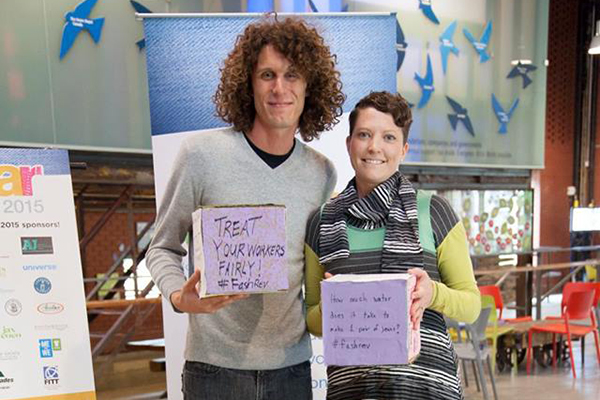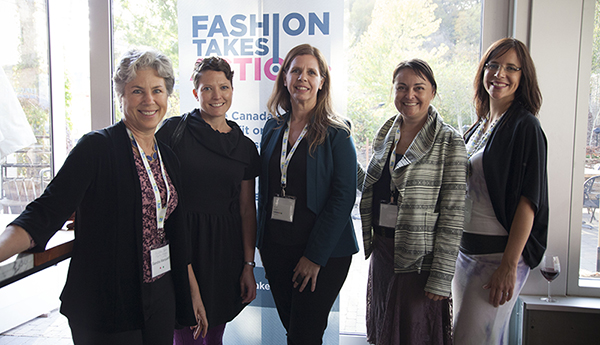8 Reasons Why Sustainable Fashion Matters
As the founding executive director of non-profit organization Fashion Takes Action, I have the pleasure of hosting the annual World Ethical Apparel Roundtable (WEAR) conference here in Toronto. WEAR brings together the global fashion industry to discuss the many social and environmental problems, as well as the solutions, that are available.
GLOBAL FASHION INDUSTRY MEETS TO DISCUSS SUSTAINABILITY
On October 19-20 the Evergreen Brick Works was abuzz with a new kind of energy and passion, not typically commonplace for the Canadian fashion industry.
Over two days, 27 speakers hailed upon Toronto and shared their personal journeys, their organizational struggles and their successes. Keynote speakers included Toronto and New York-based ethical designer Laura Siegel, and LA’s Andrew Morgan, director of the acclaimed documentary The True Cost – an exposé of the fashion industry, now available on Netflix.

Andrew Morgan, The True Cost and Kelly Drennan, Fashion Takes Action
Our panels were rich with expertise and included representatives from MEC, Bullfrog Power, Ryerson University, Me to We Style, Top Drawer Creative and the Sustainable Apparel Coalition, to name a few.
Those who attended learned several ways to engage in corporate social responsibility (CSR) practices – from reducing energy consumption and waste, to sourcing fairly made organic textiles and using low impact dyes. Meaningful discussions around supply chain transparency and storytelling rounded out the packed agenda.
As the host of such a conference, I made sure to regularly step back as a participant (although it wasn’t easy) and listen to the room. I was pleased to see that the audience was emotionally engaged. Also, in speaking directly with delegates, I came to learn how they were professionally inspired and ultimately motivated to take action.
And that was my goal.

Sandra Marquardt, Global Textile Standard; Kelly Drennan, Fashion Takes Action; Kate Black, Magnifeco; Shannon Brown, Fair Trade Canada; Adria Vasil, Now Magazine
Sustainable fashion is indeed on the rise, particularly in the UK and now the United States. Having been advocating this for over 8 years, I’m ashamed to admit that Canada falls behind our global counterparts. But showing up to WEAR is a good first step. It was a joy to see brands like Winners, HBC and Joe Fresh in the room and it makes me feel like there is still hope for a better future.
Why should we as consumers care?
8 QUICK FACTS ON HOW MUCH DAMAGE THE FASHION INDUSTRY IS REALLY DOING
1. Globally, we consume more than 80 billion pieces of clothing each year.
2. The amount of made-in-Canada clothing worn by Canadians has plummeted over the past 50 years. Clothing companies now outsource much of their manufacturing to factories in developing countries to keep prices low and trend-turnover high.
3. On average, the textile industry pollutes 5,640,000 Olympic-size swimming pools of fresh water –
every year! (Each pool holds 2500 tons of water).
4. One cotton T-shirt requires at minimum 357 gallons of water to make – equivalent to 7 full bathtubs of water and enough for one person to drink for 900 days.
5. Of the 1,600 chemicals used to dye our clothing, only 16 are approved by the Environmental Protection Agency (EPA), and 40% of this wastewater is dumped into global rivers, lakes and eventually oceans.
6. Sweatshops still exist, even in North America.
7. By some estimates, the average T-shirt travels 35,000 kilometres – equivalent to one trip around the world – before landing on your back.
8. The average North American contributes 70lbs of textiles to landfill each year
So as you can see, the apparel industry has a long way to go before reversing the damage it has caused. And while it is encouraging to see industry coming together to discuss these issues, positive change can only happen if consumers take action.
We need to become conscious consumers collectively by slowing down our purchasing, buying fewer pieces, and choosing clothing of a higher quality and will last. We also need to start asking our favourite brands some of the tough questions, like “Who makes my clothes?”
Overall, I am ecstatic with the results of WEAR, as many positive conversations took place between brands, retailers, marketers, government, non-profits, academics and supply chain experts. When you get everyone into one room together, the magic starts to happen.
And just like that, on to planning WEAR2016! Will you be there?



